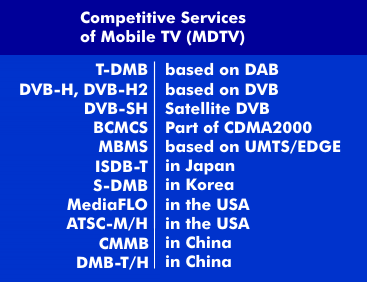DVB satellite service to handhelds (DVB-SH)
DVB Satellite Service to Handhelds (DVB- SH) is a broadcasting standard for satellite-based transmission of radio, television and for data transmission to mobile terminals. The main difference to DVB-S is that the latter is satellite-based, but designed for stationary receiving stations. Whereas DVB-H is for handhelds, but transmits terrestrially.
The actual advantage of satellite television is that a television program is broadcast nationwide from one transponder. The SH concept, on the other hand, relies on broadcasting regional programs without directional antennas, on reception without line-of-sight and indoors. It is a hybrid terrestrial-satellite system in which the satellite transponder forms the so-called umbrella cell and provides nationwide reception.
DVB-SH transmits in the S-band via satellites in the frequency range between 2.17 GHz and 2.2 GHz. The system provides for 12 to 20 channels with a maximum channel width of 30 MHz. A data rate of 128 kbit/s is envisaged for the broadcast programs.
Since DVB-SH satellite reception requires a line-of-sight( LOS) connection to the satellite, the DVB-SH system also provides for terrestrial fill-in transmitters that act as repeaters. Using these, the mobile terminal can receive the signals if no line-of-sight( NLOS) is available or the coverage area is limited in inner-city or large rural areas. Terrestrial transmission is in the UHF range and uses the UMTS transmitting stations.
The mobile receiving equipment can be designed to receive both DVB-H (handheld) and DVB-SH.

